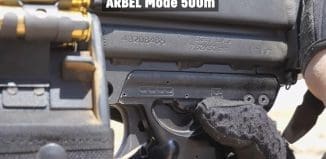The IDF’s future weapons systems
This post is also available in:  עברית (Hebrew)
עברית (Hebrew)

What does the IDF’s technological future have in store? The ground forces future arms systems and munitions, including the Armored Corps and Artillery Corps, will include a combination of autonomous robotic systems in the battlefield.
In his farewell speeches, outgoing IDF Chief of Staff Benny Gantz used the term ‘integrative’ several time. His successor, Lt. General Gadi Eizenkut, used the term ‘connectivity’. Both of them sought to describe the ideal integration between corps, between commanders and between the various weapons and systems – in order to streamline military actions as much as possible.
During his tenure, Lt. General Ganz indeed instructed IDF officers examine the future trends for the IDF in the coming decade, by 2025. The IDF website features some current and future innovations and developments underway in the framework of ground forces and robotics.
The IDF assumes the terror threat will increase and evolve over the coming decade. Consequently, the IDF will require accurate and autonomous missile and artillery fire, from airborne and naval systems as well as from tanks and infantry forces. Robots are also expected to do their bit, contributing to the general joint effort, alongside autonomous and unmanned air, ground and naval systems.
Here’s a future scenario: a military unit is entering a village teaming with enemy forces. Urban warfare is on the verge of erupting. The commander will have a smartphone in hand, complete with several options: launching a rocket or a missile, or using accurate artillery fire. Should the commander opt for rocket fire, all he or she will have to do is push the button, and order the launch. It will all be done in real time. No radio communication will be required either. Artillery Corps Artillery Corps Chief Brigadier General Roy Riftin: “This kind of smartphone will be available in 2025. Commanders will have a comprehensive image of the battlefield and will be able to apply suppressive fire (aka ‘covering fire’). The smartphone application will ‘know’ what the best source would be – airborne, rocket or gun fire.”
 Here are several Ground Corps innovations underway:
Here are several Ground Corps innovations underway:
- Dedicated rocket for urban warfare
- The IDF is using outdated guns. In 2019, a new gun is expected to enter service, feature extended range (dozens of kilometers), automatic fire and highly rapid fire rate.
 Register to iHLS Israel Homeland Security
Register to iHLS Israel Homeland Security

Armored vehicles: the Merkava 4 will continue to roll off the assembly line, along with an APC version. By 2025, a new armored vehicle will also be deployed for operation service. It is designed to be cheaper, smaller and deadlier than the Merkava 4.
- A future APC is also in the works. It will feature better protection and mobility at a lower cost.
- Observation devices under development: a radar system designed to trace fire source. This mobile radar will move along with brigade forces throughout the field, providing response to high altitude fire and monitoring sources of enemy fire.
The IDF’s and the defense establishment’s best and the brightest are currently busy developing the next generation of UGVs, unmanned ground vehicles. Here are but few of the autonomous systems in the skunkworks:
- The IDF is already using the Guardium, especially for reconnaissance missions
- By 2015, the IDF plans to have another UGV in its place. Its chassis will be based on a modified Ford 350 featuring remote control. It will also feature weapons systems, recce and additional elements. This, according to Major Trabelsi, head of Robotics at the Ground Corp.
- Another innovation under way is a robot designed to assist infantry fighters and engineering corps (who will be able to carry it themselves). It is also designed for underground warfare, that is to patrol and monitor subterranean areas as well as issue alerts in case of collapse, IED (Improvise Explosive Charges) or any lighting and ventilation issues.
- Another planned UGV is designed to be used as a front tracker, featuring weapons systems and serving as a forward sentinel capable of tracing IEDs and where enemy fire is coming from.
IDF senior staff notes the ultimate goal is to deploy future autonomous vehicles capable of overcoming battlefield barriers, chart a course independently and perhaps even fire on their own. This raises myriad issues, from safety and security to legal questions. The IDF is already using a robot capable of firing from afar on its own. Nevertheless, this system is man-controlled and operates strictly per an operator.




























